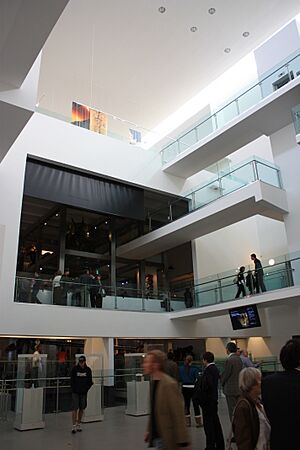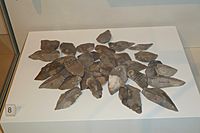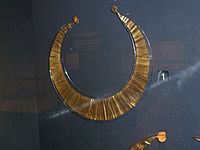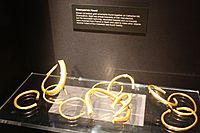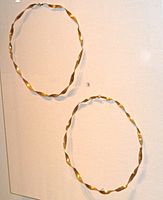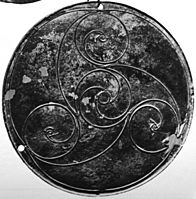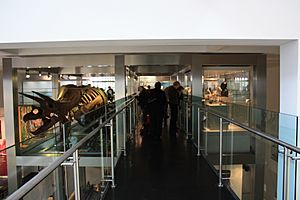Ulster Museum facts for kids
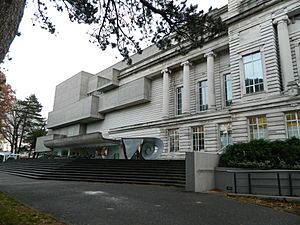
Ulster Museum exterior, 2013
|
|
| Established | 1929 |
|---|---|
| Location | Belfast, Northern Ireland |
| Visitors | 492,689 (2019) |
The Ulster Museum is a fantastic place to explore in Belfast, Northern Ireland. It's located right inside the beautiful Botanic Gardens. This museum is huge, with about 8,000 square metres (that's like 90,000 square feet!) of space for you to discover.
You can see amazing collections here, including fine art, cool applied art (like pottery and jewelry), and ancient archaeology. There are also items from different cultures around the world (ethnography), and even treasures from the famous Spanish Armada. You can learn about local history, old coins (numismatics), and how industries developed. Plus, there are awesome sections on botany (plants), zoology (animals), and geology (rocks and earth).
The Ulster Museum is the biggest museum in Northern Ireland. It's part of a larger group called National Museums Northern Ireland.
Contents
Discovering the Ulster Museum
How the Museum Started
The Ulster Museum began a long time ago, in 1821. It was first known as the Belfast Natural History Society. They started showing their collections to the public in 1833. By 1890, it also had an art gallery.
The museum was originally called the Belfast Municipal Museum and Art Gallery. In 1929, it moved to its current spot in Stranmillis. The building was designed by an architect named James Cumming Wynne.
In 1962, the museum officially became the Ulster Museum. It was recognized as a national museum for Northern Ireland. A large new part was added in 1972, designed by Francis Pym. This new section was very modern for its time.
Since the 1940s, the Ulster Museum has collected many artworks. These include pieces by modern Irish artists, especially those from Ulster.
In 1998, the Ulster Museum joined forces with two other museums: the Ulster Folk and Transport Museum and the Ulster-American Folk Park. Together, they formed the National Museums and Galleries of Northern Ireland.
Big Changes and Reopening
In July 2005, a huge project began to update the museum. It cost about £17 million! The museum closed its doors in October 2006 for this work. It reopened in October 2009, exactly 80 years after it first opened.
Many people were excited about the reopening. More than 100,000 visitors came in just one month!
What You Can See: Collections
The museum has many different galleries. They cover the history of Northern Ireland, from ancient times to today. You can also see art, fashion, and textiles. The museum also hosts special exhibitions.
Natural History Collections
The Ulster Museum has amazing scientific collections. These include Irish birds, mammals, insects, molluscs (like snails and shells), and marine invertebrates (animals without backbones). There are also many types of flowering plants, algae, and lichens. The museum even has old books and writings about Irish natural history.
The museum used to have a big exhibition about dinosaurs. While it's smaller now, you can still find a collection of rocks, minerals, and fossils. It's also home to the only known dinosaur fossil bones found in Ireland!
Irish Archaeology
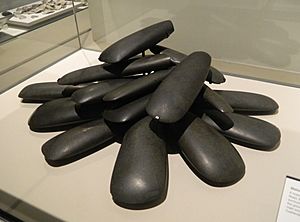
The museum has important discoveries from Northern Ireland. These include the Malone Hoard, which is 19 polished Neolithic axe heads. There's also the Moss-side Hoard of Mesolithic stone tools and the Downpatrick Hoard of Bronze Age gold jewelry. You can see parts of the Roman Coleraine Hoard and Viking coins from the Shanmullagh Hoard.
The museum also displays beautiful Bronze Age gold jewelry. Ireland is famous for these items. You can see four of the rare gold lunulae (moon-shaped necklaces). There's also early Celtic art, like a decorated bronze shield found in the River Shannon, and the Bann disc with its cool triskele design.
-
The Moss-side Hoard of Mesolithic stone tools
-
Bann disc, bronze with triskele decoration
-
Decorated bronze Yetholm-type shield, found in the River Shannon at Barrybeg, County Roscommon
Zoology: Animal Collections
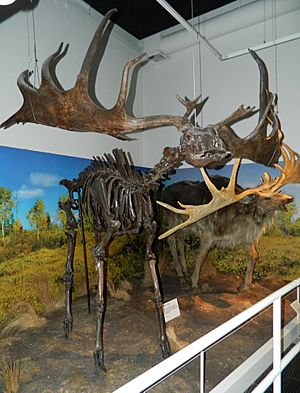
The Zoology Department has many animal specimens. These include historic collections from famous naturalists like William Thompson and Robert Templeton. You can see insects, butterflies, and shells from around the world.
The museum also has some very special individual specimens. These include:
- The Holotype (first example) of the emperor penguin.
- A skeleton of the giant Irish elk.
- The Egyptian mummified body of Takabuti.
- A Dwarf elephant skeleton from Sicily.
- Rare butterflies like Rothschild's birdwing and Queen Alexandra's birdwing.
- A Giant clam.
- The first European specimen of a Bonaparte's gull.
- A Bald eagle juvenile, the first ever recorded in Europe.
- A Thylacine (Tasmanian tiger).
- A Coelacanth (a very old type of fish).
The Zoology Department also has a collection of wildlife art. It features works by famous artists like Peter Scott and Roger Tory Peterson.
Botany: Plant Collections

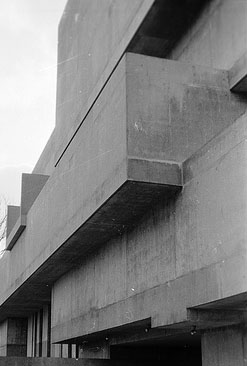
The museum's plant collection, called the herbarium (BEL), has over 100,000 specimens! It includes plants from Northern Ireland and all over the world. You can find algae, lichens, fungi, mosses, ferns, conifers, and flowering plants.
Some of the oldest specimens are algae collected by John Templeton in the late 1700s and early 1800s. Many famous botanists have contributed to this collection over the years.
Art Collections
The museum's art collection features works by important artists. These include:
Fashion and Textiles
The Ulster Museum has a wonderful collection of fashion and textiles. It shows how clothes have changed from the 1700s to today. There are about 5,000 items, including clothes, accessories, jewelry, and even dolls and toys.
The museum collects pieces that are well-designed or show important changes in fashion history. You can see 18th-century silk gowns, early 20th-century Parisian couture (high fashion), and modern international styles. Famous designers like Chanel, Dior, Alexander McQueen, and Vivienne Westwood are represented.
The textile collection also includes beautiful embroidered pieces by Irish women. One special item is the 'Lennox Quilt' from 1712. There are also two large linen wall hangings by the French artist Henri Matisse.
Rebuilding the Fashion Collection
Sadly, most of the museum's original costume and textile collection was lost in a fire in 1976. This happened at Malone House, where the collection was stored.
After the fire, the museum worked hard to rebuild its collection. They focused on collecting fashion as an art form, showing the styles and culture of different times. The museum was able to buy many historic fashion items and couture pieces from auctions.
Today, the museum has an amazing collection of 20th-century high fashion and modern styles. They collect new pieces every year to show current trends. This includes items from famous designers and popular high street brands.
Ethnographic Collections
This collection features items from different cultures around the world. You can see:
- Chola art and Bronze statues from the Chola Dynasty.
- Samurai armour.
- A war canoe from the Solomon Islands.
Girona Treasures
In 1971, the museum acquired incredible artifacts from the Spanish Armada ship, the galleass Girona. This ship sank off the coast of Ireland in 1588. You can see cannons and other treasures from this famous shipwreck.
Getting There
The closest train station to the Ulster Museum is Botanic. Regular trains run between Belfast Grand Central, City Hospital, Botanic, and Belfast Lanyon Place.
See Also
- Irish art
- List of tourist attractions in Ireland


